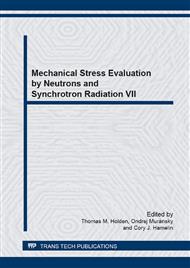p.142
p.148
p.155
p.161
p.165
p.171
p.176
p.182
p.188
Characterization of Thermally Stable Diamond Composite Material
Abstract:
Diamond composite materials are being used increasingly in cutting tools for both the mining and manufacturing industries. Except for the low pressure CVD and SPS methods, most SiC based diamond composites are produced under high pressure and high temperature (HPHT). The dominant binder phase is SiC and these composites are classed as thermally stable and are referred to as TSDC (thermally stable diamond composite). TSDC composites are produced by reactive sintering either within the diamond stability field, ~1500°C and ~5.5 GPa, or in the graphite phase field at ~1550°C and ~2 - 3.5 GPa as originally patented by Ringwood. Unlike the traditional polycrystalline diamond composite (PCD) that use Co as the binder phase and operate under restricted temperature conditions, usually less the 800°C, TSDC is Co-free allowing the operational temperature range for TSDC to be extended substantially. Extensive experimental research has been conducted at the CSIRO (Commonwealth Scientific & Industrial Research Organization) Rock Cutting Laboratory to assess the quality of TSDC products through a series of in-house tests that have been developed (abrasive wear test, compressive and shear testing) to facilitate their use in the mining industry. The focus is to prevent TSDC from premature failures in drilling and cutting operations. Since the wear resistance and performance in general, of TSDC cutting elements are strongly dependent on the phase composition, phase distribution (microstructures) and phase interaction (microstresses), detailed studies of TSDC have been undertaken using optical, SEM (with EDS and CL), Raman microscopy and radiographic imaging of macro defects as well as x-ray and neutron diffraction. Residual stress measurements were made using the neutron diffractometer Kowari at OPAL research reactor in the diamond and SiC phases in two TSDC samples. The microstresses that developed in these phases as a result of quenching from high sintering pressure and temperature and the mismatch of the thermo-mechanical properties of SiC matrix and diamond inclusions were evaluated. The matrix-inclusion concept has also been used to calculate stress partition in the phases of the TSDC products that can be directly comparable with the experimental data and give clearer interpretation of the experimental results.
Info:
Periodical:
Pages:
165-170
Citation:
Online since:
February 2014
Authors:
Keywords:
Price:
Сopyright:
© 2014 Trans Tech Publications Ltd. All Rights Reserved
Share:
Citation:


